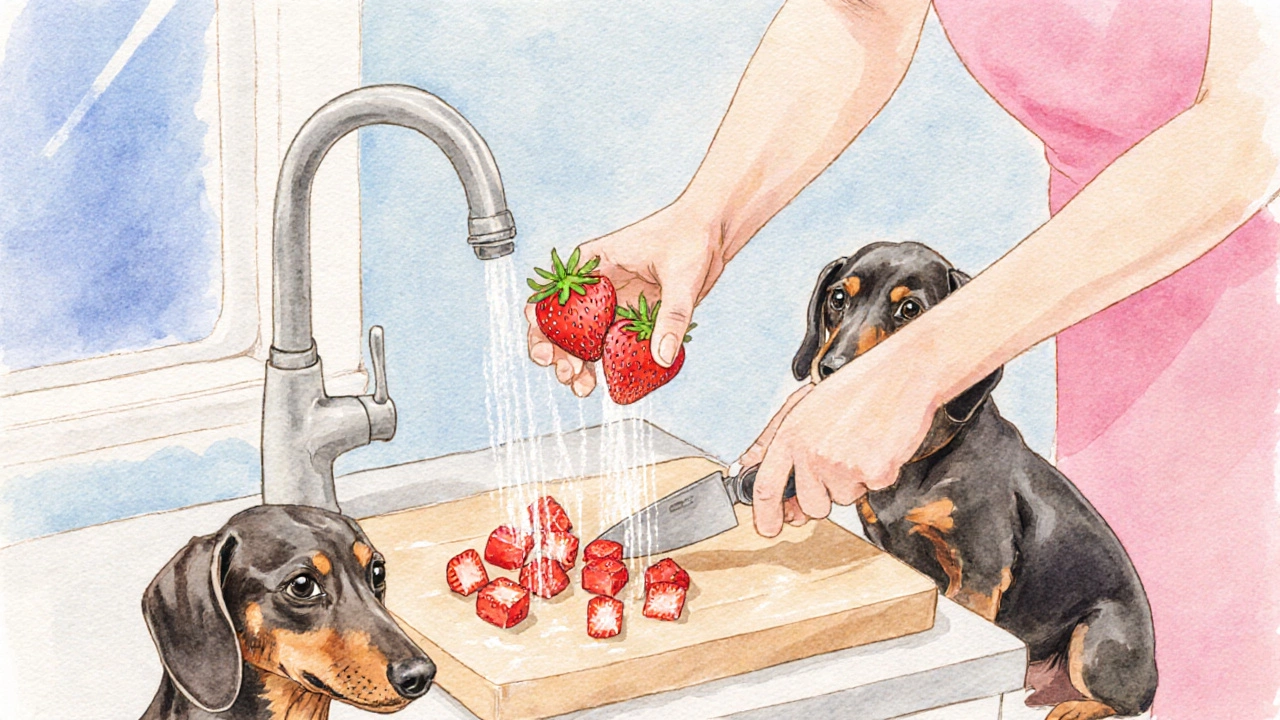Strawberry Feeding Calculator for Dogs
Safe Strawberry Calculator
Calculate how many strawberries are safe for your dog based on weight, age, and health conditions.
Safe Strawberry Amount
Important Notes
Always wash strawberries thoroughly, remove stems, and slice into small pieces. Monitor for any adverse reactions. Treats should not exceed 10% of daily calories.
Wondering if you can share that sweet, red berry with your four‑legged friend? Below you’ll get the facts on whether strawberries are safe for dogs, what they bring to the table nutritionally, and how to serve them without risking a tummy upset.
Quick Summary
- Fresh strawberries are non‑toxic to dogs and can provide vitamins, antioxidants, and fiber.
- Feed in moderation - a few small pieces for a medium‑size dog, less for smaller breeds.
- Always wash, remove stems, and slice to avoid choking.
- Watch for sugar content if your dog is diabetic or overweight.
- Consult a vet before adding any regular fruit supplement to your dog’s diet.
Strawberry is a small, red fruit that belongs to the Rosaceae family. It’s packed with vitamin C, manganese, folate, and a suite of antioxidants called anthocyanins. Those nutrients are why many pet owners wonder if a strawberries for dogs treat could boost canine health.
What Makes Strawberries Appealing for Dogs?
Dogs are naturally curious about the smells and textures of fresh produce. Strawberries offer a juicy bite and a sweet flavor that can be a low‑calorie alternative to store‑bought treats. Their high water content (about 91%) also helps with hydration, especially on hot days.
Key Nutrients and Their Effects on Canine Health
Below is a snapshot of the main nutrients in a typical 100‑gram serving of strawberries and what they mean for your dog:
| Nutrient | Amount (per 100g) | Benefit for Dogs |
|---|---|---|
| Vitamin C | 58mg | Supports immune function and joint health |
| Fiber | 2g | Improves digestion and stool quality |
| Anthocyanins (antioxidants) | ≈1mg | Helps combat oxidative stress |
| Manganese | 0.4mg | Assists bone formation and metabolism |
| Sugar (natural) | 4.9g | Provides quick energy - watch for excess |
Are There Any Risks?
While strawberries aren’t poisonous, a few issues can arise if you’re not careful.
- Gastrointestinal upset - Overeating can cause diarrhea or vomiting, especially in dogs with sensitive stomachs.
- Sugar load - Dogs with diabetes, obesity, or pancreatitis need strict sugar control.
- Choking hazard - Whole berries or large pieces can block airways in small breeds.
- Allergic reaction - Rare, but some dogs may develop itching or swelling.

How Much Is Safe?
Rule of thumb: Treats, including fruit, should make up no more than 10% of a dog’s total daily calories. For a 20‑kg (44‑lb) dog that needs about 900kcal per day, that’s roughly 90kcal in treats. A single medium strawberry contains about 4kcal, so a handful (5‑7 berries) stays well within safe limits.
Smaller dogs (5‑10kg) should get just one or two pieces. Puppies get even less, as their digestive systems are still developing.
Preparing Strawberries for Your Dog
- Wash thoroughly under running water to remove pesticides or dirt.
- Remove the green stem and leaf; they’re fibrous and can irritate the mouth.
- Slice into bite‑sized pieces (¼‑inch cubes work for most breeds).
- Serve fresh or frozen. Frozen slices can be a soothing summer snack.
- Do NOT add sugar, chocolate, or any human‑grade toppings.
When to Skip the Strawberry
Consult a veterinarian (see Veterinary professional) before feeding strawberries if your dog has any of these conditions:
- Diabetes mellitus - extra sugar can destabilize blood glucose.
- Pancreatitis - high‑sugar foods may trigger inflammation.
- Obesity - treat calories add up quickly.
- Known food allergies - start with a single bite and monitor.

Alternative Dog‑Friendly Fruits
If your pooch loves fruit but you need variety, these are also safe in moderation:
- Blueberries - rich in antioxidants, low sugar.
- Apple slices (no seeds) - provide fiber and vitamin A.
- Banana - potassium boost, but higher in carbs.
- Watermelon (seedless) - great hydration.
Remember the same preparation rules: wash, remove pits or cores, and keep portions small.
Common Questions Dog Owners Ask
Below are quick answers to the most frequent concerns about feeding strawberries to dogs.
- Can a dog eat a whole strawberry? Yes, but only a few at a time. Too many can cause loose stools.
- Is frozen strawberry safe? Absolutely - just make sure the pieces are small enough not to be a choking risk.
- Can I blend strawberries into my dog’s food? You can mix a spoonful into wet food for added flavor, but keep the overall fruit portion low.
- What about canned strawberries? Avoid them. Canned fruit often contains added sugar and syrups, which are unnecessary calories for dogs.
Final Thoughts
Strawberries are a tasty, nutrient‑dense fruit that most dogs can enjoy safely when offered in moderation and prepared correctly. They can add vitamin C, fiber, and antioxidants to a balanced diet, but they’re not a substitute for a complete canine nutrition plan. When in doubt, ask your vet and start with a tiny piece to see how your dog reacts.
Frequently Asked Questions
Can strawberries cause diabetes in dogs?
Strawberries themselves do not cause diabetes, but their natural sugar can elevate blood glucose if given in large amounts. Dogs prone to diabetes should receive only occasional, very small portions, and always under veterinary guidance.
How many strawberries can a small 5‑kg dog have?
One to two small berries per day is a safe limit for a 5‑kg dog. This provides a taste without overloading their calorie budget.
Should I remove the strawberry seeds?
Strawberries have tiny, soft seeds that are generally harmless. The bigger concern is the green stem and leaf, which should be trimmed off.
Can I give my dog strawberry‑flavored dog treats?
Yes, as long as the ingredient list shows real strawberries and no added sugars or artificial sweeteners (especially xylitol, which is toxic to dogs).
My dog ate a whole bowl of strawberries. What should I do?
Monitor for signs of diarrhea, vomiting, or abdominal pain. If any symptoms appear or if your dog has a pre‑existing condition, contact your vet promptly.
